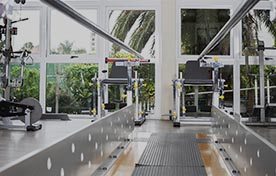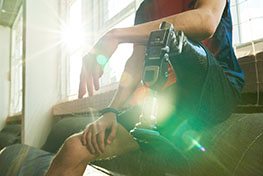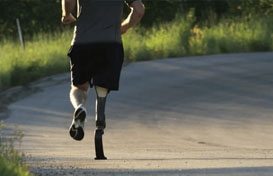– by Douglas G. Smith, MD

Just as arms and legs are different, there’s a world of difference between prosthetic devices for upper and lower limbs.
Basically, lower-limb prostheses are required to do two things: enable a person to stand and walk. But the demands of upper-limb prostheses are vastly different. As we’ve noted in our previous two articles, hands perform a wide variety of tasks, from the delicate and complex to the strong and forceful. An ideal prosthetic hand would do all of these things. Unfortunately, we haven’t yet created a device that can perform the tremendous array of functions routinely done by our natural hands.
The hand is also one of the most important elements of our self-image, second only to the face. Our hands are a tremendous part of how we present ourselves to others. In addition to interacting with the environment in so many functional ways, our hands are a significant part of our psychological and social selves, and are a vital element in our sense of feeling whole. Far more than lower-limb prosthetics, an ideal upper-limb prosthesis would have a life-like appearance, including skin tone, veins, hair texture and color, even wrinkles and creases, in addition to life-like power and functional ability.
There’s No Substitute for the Real Thing

Despite the variety of upper-limb prostheses currently available, we still haven’t figured out how to make one that duplicates what God gave us. Sensation, dexterity, grip patterns — these are things nature provides that we just can’t match electronically or mechanically. Eighteenth century poet and hymn writer William Cowper said, “God made the country, and man made the town.” What we create looks “manmade,” for obvious reasons. We have a long way to go before the form and function of upper-limb prostheses come anywhere close to matching those of a natural hand.
Like our hands, the joints in our upper limbs are capable of numerous movements. Your wrist bends and rotates. Your elbow does the positioning. Your shoulder moves forward, back, side to side, up, down and all around. It rotates. A prosthetic elbow bends and extends. A prosthetic shoulder goes forward and back. Prosthetic joints perform only a minimum of the functions of our complex natural joints. An artificial hand opens and closes — this is its site of control. If we could make a hand that could do everything a natural hand does, its sites of control would be too numerous to count.
Using the Residual Arm Without a Prosthesis

When a person loses both arms, he or she usually wears upper-limb prostheses nearly full-time, out of sheer necessity. But a person who loses one arm can learn to do most things one-handed by using the remaining portion of the amputated arm, without a prosthesis. As an individual becomes increasingly adept at one-handed skills, the need for wearing a prosthesis diminishes. In contrast, an individual with a lower-limb amputation, who is able to walk with a prosthesis, generally chooses to use it full-time. Many people with an upper-limb amputation choose to use a prosthesis only part time, for specific tasks, or not at all.
It’s not uncommon for a person with an above-elbow amputation to carry things with the residual limb, using the core of the body for support. A person with a below-elbow amputation can also hold things in the crook of the elbow or against the body. While sitting at a table or desk, a person can use both the affected and unaffected arms for stability, to keep from leaning to one side.
Human beings are very adaptable and innovative creatures. We use what we have. Even if your hand was bound with tape, leaving you unable to grasp, you’d be amazed at how much you’d continue to use your arm to push, pull, carry and position things, sometimes without even having to look at an object. This is more difficult to do with a prosthesis. A prosthesis gives the person greater ability to grasp and manipulate objects, but it’s both physically and mentally demanding. For some people, it can be like using their natural hand while wearing a thick glove. There is no sense of contact with the environment. It doesn’t feel as if it’s a part of them.
Interestingly, many lower-limb amputees eventually identify a sense of routine and comfort with their prosthesis. This feeling is very rare with upper-limb amputees. As a lower-limb amputee steps down into a prosthesis while walking, the wearer feels the sensation of vibrations through the prosthesis, giving feelings of contact with the ground. The wearer can sense the textures and slope of the surface that’s being walked on. But with an upper-limb prosthesis, the device feels as if it’s hanging on the end of the residual limb. The vibrations of contact with an object are much weaker because the sensory input to the residual arm is blocked. The act of removing an upper-limb prosthesis is often described as feeling relieved and reconnecting with the environment.
“Doc, the Darn Thing Keeps Getting Pulled Off!”
Gravity often works against a person with an upper-limb prosthesis. The prosthesis itself can weigh several pounds, and it tends to pull away from the residual limb at a crucial moment when trying to lift something with it. For example, even an 8-pound gallon of milk can make it feel like the entire prosthesis is being pulled right off the body.
This helps illustrate an important difference between people with upper- and lower-limb loss: prosthetic fit and that “connected” feeling, a difference that is often misunderstood. With lower-limb prostheses, the “connection” between the person and the device — the “man/machine interface” — is reinforced when the person steps down into the socket, pushing the prosthesis onto the residual limb. It feels more securely attached. On the other hand, since an upper-limb prosthesis pulls away from the limb when lifting something, it can actually feel disconnected.
Imagine carrying a 2-pound weight in your hand as you go about your daily routines. It doesn’t sound like much, but it wouldn’t take long before you felt that extra weight dragging down on your arm and shoulder, feeling heavier and heavier. A prosthesis is added weight on your arm, shoulder and back. People with upper-limb loss commonly describe their prostheses as cumbersome because of the weight and sway factors. And the higher the amputation level, the heavier the device feels. Even if the weight of the prosthesis matches the weight of the part of the limb that was lost, it still feels heavy.
Many people with upper-limb loss describe feelings of upper-body asymmetry (lopsidedness). Some stand with the shoulder of the amputated side posturally higher. Reflexively, a person may feel more balanced when the shoulder on the amputated side is lifted higher, even when not wearing a prosthesis. And when the person wears a prosthesis, he or she flexes the muscles to support the additional weight and to counter centrifugal force. These factors can cause postural asymmetry, leading to discomfort in the back and neck. It’s not uncommon for a person with upper-limb loss to develop a type of postural scoliosis (curving of the spine).
I believe that much of the problem I call “connectedness” will eventually fade with the direct attachment of prosthetic devices to the skeleton (osseointegration). Most of the early trials have been conducted in Sweden. Osseointegrated prosthetic attachment surgery has been performed on upper limbs, but even to a lesser extent than on lower limbs. In my opinion, the benefits of a skeletally attached prosthesis are probably greater for upper limbs than for lower limbs.
Why Do Some People Use Their Prosthesis More Than Others?

How skilled people become in using a prosthesis, how natural it feels, and how often they use it is highly dependent on the level of amputation. For example, about 80 percent of my patients with below-elbow amputations use their prosthesis daily. But while having a prosthesis is incredibly important for people with above-elbow amputations, only about 20 percent use one regularly. There are several reasons for this dramatic difference.
Just as the knee and hip are important for lower-limb weight-bearing, the elbow and shoulder are vital for upper-limb placement. Our shoulder and elbow connect with the brain to give us an acute sense of arm and hand position. The brain, elbow and shoulder act as the “global positioning system” for the hand. This GPS locates the hand in space and lets you put it where you want it, automatically and with great precision. A skilled tennis player doesn’t need to see the racket to know where it is. The elbow and shoulder position the racket precisely to hit the ball. The shoulder positions the arm in space, and the elbow acts as an “erector set” to lengthen or shorten the arm accordingly.
But we tend not to realize this until we’ve lost it. A person with a below-elbow amputation still has the natural positioning power of his or her shoulder and elbow. But losing an arm above the elbow takes away this amazing positional feedback between the limb and brain. There’s no longer that precise sense of the location and position of the hand.
Using a prosthesis becomes more complicated as the amputation level rises. These difficulties are dramatically amplified for a person who loses an arm at the shoulder. Suspension systems for shoulder-level amputees are bulky and heavy. Remember the scenario of carrying a 2-pound weight all day? Now imagine wearing shoulder pads or a backpack instead. As the amputation site gets closer to the core of the body, it becomes increasingly cumbersome. People with shoulder-level amputations rarely wear a prosthesis full-time; it’s far more task-oriented.
People with below-elbow amputations have the most success using prosthetic devices because the elbow and shoulder give them a sense of where the end of the prosthesis (the terminal device) is located in space. The focus then is on whether the terminal device is open or closed and how to operate it.
Usefulness, Rather Than Time, Is the True Measure of Value
When asked, “How many hours a day do you wear your prosthesis?” if the person says, “12 hours,” we think it’s a success. If the answer is “Two hours,” we think it’s not. But it’s a mistake to equate the length of time a prosthesis is used with its level of usefulness. For the person who decides he or she only needs the prosthesis for two hours a day, the device is indispensable during that time. Deciding that the prosthesis isn’t needed during the rest of the day doesn’t diminish its value.
Measuring time of prosthetic use is more relevant for people with lower-limb amputations because lower-limb prostheses are fundamental to performing ongoing tasks such as walking or standing. For people with an upper-limb amputation, the use of the device is more task-based. Measuring the usefulness of the prosthesis then depends a great deal on the renewed ability to manage certain tasks that can’t be done without it. Whether that happens on an hourly, daily or weekly basis is irrelevant. If a prosthesis allows a person to perform certain tasks or activities, whether they’re work-related or recreational, then it has value and it is medically indicated, even though it’s not used full-time.
Prosthetic use is a complex and ongoing challenge. Matching a person with the right prosthesis is a significant part of that challenge. A wide range of devices are available to meet a wide range of prosthetic needs, from simple but effective cable and hook devices to high-tech and complex myoelectric and hybrid prosthetics. In Part 2 of our look at upper-limb prostheses, we’ll focus on specific types of prosthetic devices and how they operate.
I’m fond of the following quote by singer/actress Pearl Bailey: “There are two kinds of talent, man-made talent and God-given talent. With man-made talent you have to work very hard. With God-given talent, you just touch it up once in a while.” If you reread the quote, substituting the word “arm” for “talent,” that seems to sum up what I have been trying to say.
Disclaimer: The following information is provided and owned by the Amputation Coalition of America and was previously published on the website http://www.amputee-coalition.org or the Coalitions Newsletter, inMotion.








